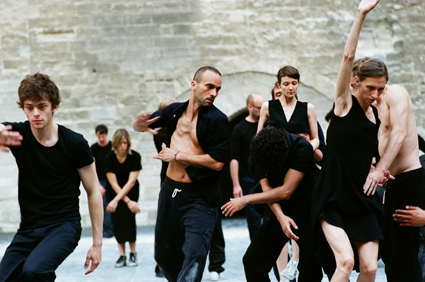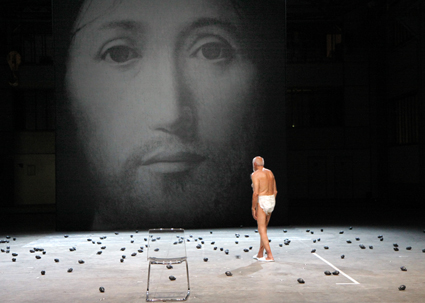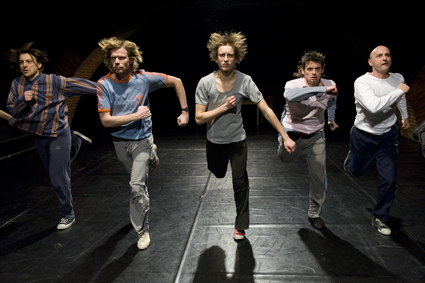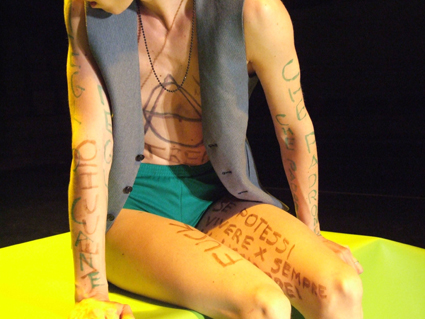contemplation, shit and activism
alex lazaridis ferguson: festival transamériques, montreal 2012

Cesena, Anne Teresa de Keersmaeker and Bjorn Schmelzer
photo Anne Van Aerschot
Cesena, Anne Teresa de Keersmaeker and Bjorn Schmelzer
THE SEATING CAPACITY OF THEATRE MAISONNEUVE IS 1,458. IT’S A BIG HALL THAT COMES WITH AN APPROPRIATELY VAST STAGE. SO WHEN A LIGHTING DESIGNER CHOOSES TO ILLUMINATE THAT STAGE WITH ONLY ONE SMALL FLUORESCENT LIGHT UNIT, I HAVE TO WONDER WHAT THEY’RE UP TO. THE INTENT BECOMES CLEAR AFTER A FEW MINUTES.
rosas: holy communion achieved
A lone performer, barely visible, arrives at the front of the apron and begins to vocalise. He drones, gasps, intones, and growls. I can just make out the grey outline of his flexing, heaving ribs. Soon his voice is joined by other voices issuing from the shadows. They harmonise in modalities that originate in Renaissance and Middle Ages church and folk music. While the lights give me just enough visibility to place the first performer, the new voices won’t let me fix sound to figure. I must receive with my ears only.
Cesena, by Anne Teresa de Keersmaeker and Bjorn Schmelzer (Belgium), was originally performed outdoors at the Palace of the Popes in Avignon, France, starting in pre-dawn half-light at 4.30 am. The indoor version parallels the transition to full morning light without attempting to mimic nature. More light will come as the show progresses.
Perhaps the most remarkable thing about this collaboration between choreographer and musical director is the way dancers and singers are seamlessly integrated. The greatest vocal challenges are left to the singers, and the most difficult movement solos are left to the dancers; but for the most part the bodies all sing and move—to very high standard. Walking, turning, rolling and singing with collective intent, the performers form a community of initiates with a holy mission: to awaken the sun—or its proxy, electric light. They succeed. My primal fears are allayed by the light, and my spiritual yearnings, associated with Gregorian chanting and the like, are fulfilled.
societas raffaelo: communion interrogated

On the Concept of the Face, Regarding the Son of God by Societas Raffaelo Sanzio
photo Klaus Lefebvre
On the Concept of the Face, Regarding the Son of God by Societas Raffaelo Sanzio
On the Concept of the Face, Regarding the Son of God by Societas Raffaelo Sanzio (Italy) is an exercise in testing your faith—or if you don’t have any of that, your patience. A modernist apartment done almost exclusively in white is stretched across the wide expanse of the Theatre Jean Duceppe. An old man in a white bathrobe sits on a white couch on a white vinyl floor watching TV. He shits himself repeatedly. His middle-aged son, in black suit and white shirt, repeatedly cleans him up. The son dons latex gloves, removes the old man’s diaper, sponges him down, and mops up the brown mess on the floor with white towels. He is a patient and loving son, but he sometimes becomes exasperated. The old man cries and begs forgiveness. All the while Jesus, the world’s original forgiver, watches on, his face rendered in enigmatic detail by Renaissance painter Antonello da Messina and blown up by director Romeo Castellucci to massive proportions on a panel that stands upstage centre. Jesus’ expression is hard to read. Is it one of bemusement, empathy, or judgment?
Castellucci seems to have created all this as a test. Certainly for the characters—will the two men give in to despair? But also for the audience—as we watch the dreary and sometimes comical routine we are assaulted with the acrid odour of shit. Yes, Castellucci has polluted the theatre with a sulphurous stink. Some spectators hold their nostrils shut. As usual with Castellucci, the visceral nature of the experience is also a theatre game. While “regarding the face of the son of God,” I try to discern his attitude to the two men; I check my empathy levels while having my senses assaulted; I negotiate with the representation before me—to what degree do I identify with, and care about, the real-life situation portrayed? During one of the son’s exits for towels, the father unscrews the lid of a jug and pours more brown fluid over himself and the whiteness of sheet, blanket and floor. The son returns to find the father crying and begging forgiveness again. Who is testing whom? Later in the show, about a dozen pre-teens throw metal, grenade-like missiles at the giant face of Jesus, achieving not a dent. They then sit and contemplate the image. Jesus remains impassive. Someone just passed or failed a test again, but I can’t tell who.
madlinsko theatre: out of the body & in your face

Damned Be the Traitor of His Homeland, Mladinsko Theatre
photo Ziga Koritnik
Damned Be the Traitor of His Homeland, Mladinsko Theatre
Director Oliver Frilic and Mladinsko Theatre (Slovenia) assemble an arsenal of actor-bodies shoved in numbers as far forward as the stage will allow for Damned Be the Traitor of His Homeland. They will ask some difficult questions of the audience at Theatre Rouge du Conservatoire and make some uncomfortable accusations. But first each actor creates a fictional eulogy for him or herself, and each successive account of the circumstances of their passing is more improbable than the last. In this way, authenticity of personal narrative is thrown into doubt from the outset. In one scene the company interrogates one of its members in a chummy but dangerous manner: where do his allegiances lie? Is he really Slovenian? Isn’t one of his parents a Croat? Didn’t he sing songs in the pub with Serbian soldiers? The diversity of the actor’s ancestry is such that the whole notion of ethnic identity is made to look a very dubious construct. But if so, how did we get to the atrocities of ethnic cleansing in the former Yugoslavia? Instability of ethnic identity is starkly contrasted with a sense of deep personal loss at the fracturing of Yugoslavia. Each actor recalls the moment they learned of former President Tito’s death in 1980. They strip naked before us and cry. The sense of loss—of a country, of a time without war—is affecting. Some of us in the audience are crying too.
Eventually, the actors ask the spectators, “Where were you when the slaughter in Srebrenica was taking place only 400 kilometres from here?” Of course, they don’t ask this when performing in Montreal. They find other ways to challenge the Canadian audience: for example they note that Canada’s oppressive Indian Act provided much of the basis for South Africa’s system of apartheid. With blanks fired loudly and frequently from a pistol, and with most of the show occurring almost in the lap of the audience, Damned Be the Traitor is a shock and awe performance that keeps me alert and on edge. The ‘awe’ part is largely in the handling of pace and rhythm by the director. Frilic’s sense of proportion is impeccable. He knows when to shift gears and when to surprise. As a result Damned Be the Traitor is a well-oiled, political-funhouse ride, one with amusements that turn nasty but never feel gratuitous.
motus: process makes imperfect

Too Late! (Antigone) Contest #2, Motus
photo End & DNA
Too Late! (Antigone) Contest #2, Motus
Too Late! (Antigone) Contest #2 by Motus (Italy) was inspired by the 2008 killing of teenager Alexandros Grigoropoulos at the hands of police in Athens, Greece. Motus partly builds its show from the script of Sophocles’ Antigone, with one actor, Vladimir Aleksic, tending to play the role of the dictator Creon and the other, Sylvia Calderoni, tending to play the defiant outcast Antigone. The work is strongest when it stays close to the original text; there’s more than enough complexity in Sophocles to allow for a nuanced examination of the abuse of state power. Early on, dialogue is juxtaposed with the two actors playing dominant and submissive dogs—a simple parallel to the power relationship in the play, but one made effective by the detailed physical work. As is typical in art-market political theatre, the company turns the lens on its own creative process and the focus of the piece becomes diluted by meandering speculations about power and identity woven with personal biography. Unlike Damned be the Traitor, which uses similar techniques but in a tightly focused manner, the inspiration for Too Late!, charged by Grigoropoulos’ death, simply dissipates. Despite the political posturing, it feels like nothing much is at stake.
–
FTA: Festival TransAmériques 2012, Montreal, Canada, May 29-June 4; for credits and company sites, see www.fta.qc.ca/en
RealTime issue #110 Aug-Sept 2012 pg. 16






